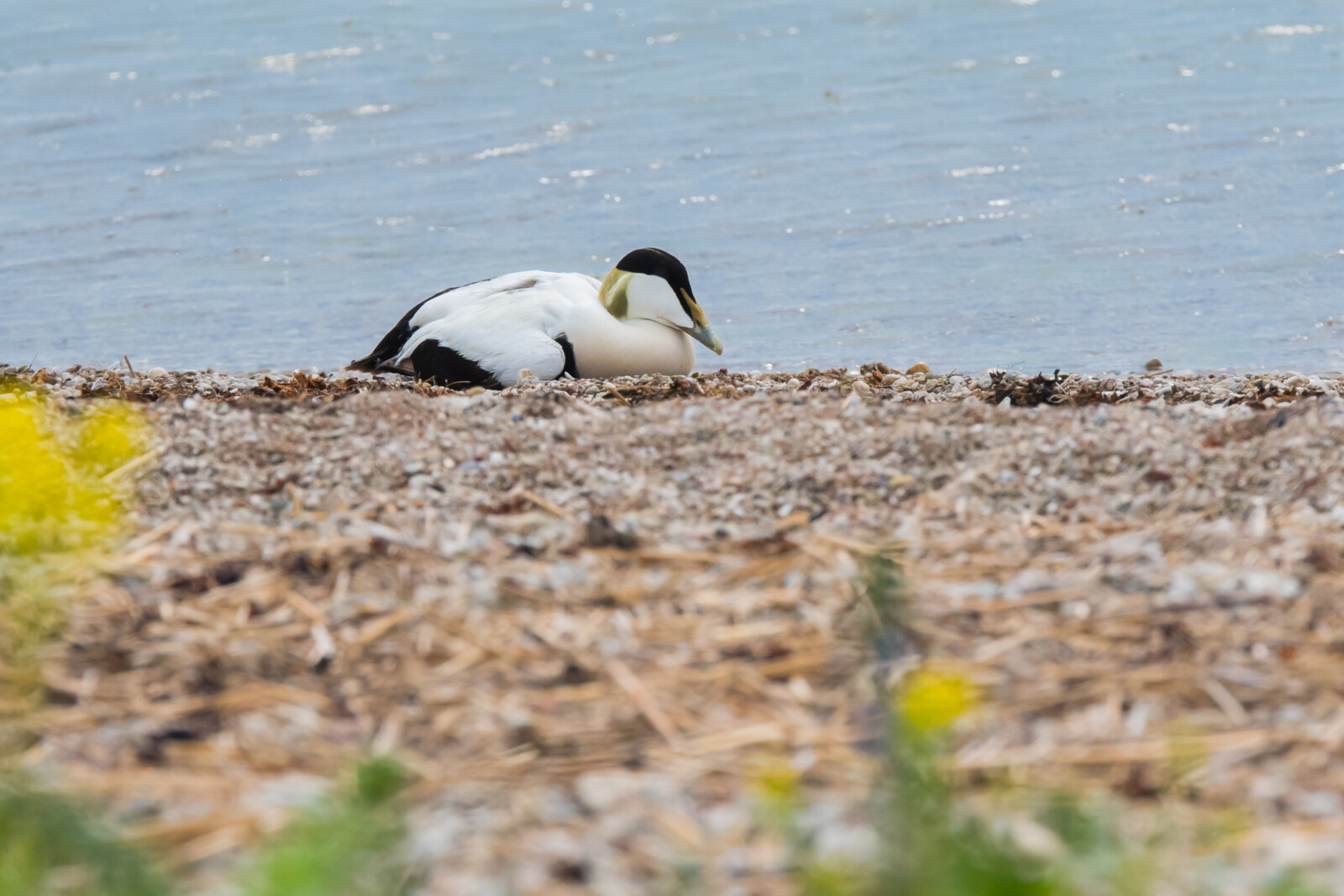Common eider
Common eider. Photo: Peter Lind
Introduction
Latin Somateria mollissima (L.)
Estonian Hahk
Also known as: St. Cuthbert’s duck, Cuddy’s duck
Status in Estonia
Breeding, migratory and wintering bird.
Description
The common eider is a large and stocky waterfowl with a rather stocky neck, a large head and a long wedge-shaped beak. In flight, it appears heavy: the wings are wide and quite short, the wing beats are sluggish and the head is slightly down. The male bird’s definitive plumage is mostly white, with a black underside, sides and back, a circular white ‘thigh patch’ and short white tertials. The white head features a black wide stripe and green sides on its nape. The female bird is brown, with dark stripes, the secondaries are dark with a white edge. The male bird in eclipse plumage is very dark with no streaks, top wing coverts and long curly tertials are white. The juvenile looks similar to the female, but the secondaries lack a white edging and the head and top are monochrome.
Size
Body length 60–70 cm, wingspan 95–105 cm, body mass 1.2–2.6 kg.
Similar species
Steller’s eider.
Distribution
Its distribution is circumpolar, with multiple distinct subspecies. In Estonia, it is mostly found in the islands of Western Estonia and the coastal area of Northern Estonia.
Population
Estonia has 1500–2500 breeding pairs.
Occurrence in Estonia
It arrives in spring at the end of March, earlier if the ice melts or if the sea is not frozen. The migration of northern breeders continues until mid-May. Autumn migration begins in July/August with male birds coming to moult, followed by female and juvenile birds migrating and leaving in October through November. Common eiders winter in the same areas where they breed, primarily in the North Sea, Denmark and Germany. About 10–30 birds winter in the Estonian ice-free sea.
Diet
It feeds on mussels and crustaceans up to 40 mm in size. It obtains food through skilled diving and by grabbing them in shallow waters. The strong and slightly sharper beak is designed to pry the shells from their attachment point and dig in silt. It has been observed that, unlike other ducks and geese, it can occasionally capture and consume smaller fish. It doesn’t really consume plants.
Habitat
It primarily inhabits small sea islands but can also be found on the capes of larger islands that reach far into the sea. Generally, it favours rocky islands and islands further from the beach. On forest-covered islands, the common eider inhabits the coast exclusively, leaving the juniper patch only when it can no longer fit through it.
Nesting
The nest can be found practically anywhere, including on a beach bank, seaweed embankment, or just next to some rocks, between rocks, in the grass, beneath a mountain currant bush, or under a juniper tree or a rock. The nest is lined with lots of down feathers. The female lays 3–8 green-shelled eggs in early May and incubates them for 25–26 days. The chicks hatch around the end of May and learn to fly between July and August. The broods stay far out to sea and sometimes form joint families with 40 or more chicks. In June, males moult on remote banks (sometimes up to 10 kilometres from the coast).
Conservation status and protection
Not under protection. The biggest threats are foxes and common raccoon dogs that live on the islands as well as great black-backed gulls and European herring gulls who assault their nests. In the last 10 years or so, seagulls have frequently killed the brooding female on the nest.
Distribution and population in Lääne County
The common eider is a common migratory bird in Lääne County’s marine areas as well as an uncommon breeding bird along the coasts. Decades ago, the common eider was one of the most popular breeding birds along the Väinameri in Matsalu National Park. Unfortunately, their numbers began to decline rapidly in the last decades of the twentieth century.
In Lääne County, the common eider is most likely to be seen on Cape Põõsaspea. In Matsalu National Park, these sea-ducks are best seen on the Puise Peninsula.
